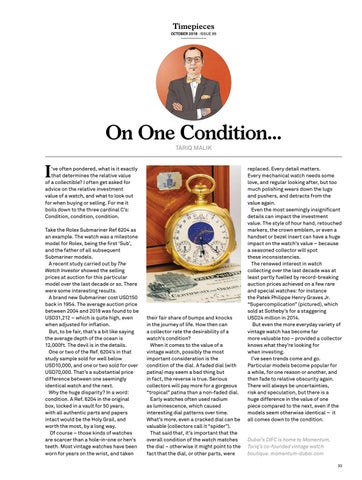Timepieces OCTOBER 2018 : ISSUE 89
On One Condition... TARIQ MALIK
I
’ve often pondered, what is it exactly that determines the relative value of a collectible? I often get asked for advice on the relative investment value of a watch, and what to look out for when buying or selling. For me it boils down to the three cardinal C’s: Condition, condition, condition. Take the Rolex Submariner Ref 6204 as an example. The watch was a milestone model for Rolex, being the first ‘Sub’, and the father of all subsequent Submariner models. A recent study carried out by The Watch Investor showed the selling prices at auction for this particular model over the last decade or so. There were some interesting results. A brand new Submariner cost USD150 back in 1954. The average auction price between 2004 and 2018 was found to be USD31,212 – which is quite high, even when adjusted for inflation. But, to be fair, that’s a bit like saying the average depth of the ocean is 12,000ft. The devil is in the details. One or two of the Ref. 6204’s in that study sample sold for well below USD10,000, and one or two sold for over USD70,000. That’s a substantial price difference between one seemingly identical watch and the next. Why the huge disparity? In a word: condition. A Ref. 6204 in the original box, locked in a vault for 50 years, with all authentic parts and papers intact would be the Holy Grail, and worth the most, by a long way. Of course – those kinds of watches are scarcer than a hole-in-one or hen’s teeth. Most vintage watches have been worn for years on the wrist, and taken
their fair share of bumps and knocks in the journey of life. How then can a collector rate the desirability of a watch’s condition? When it comes to the value of a vintage watch, possibly the most important consideration is the condition of the dial. A faded dial (with patina) may seem a bad thing but in fact, the reverse is true. Serious collectors will pay more for a gorgeous “tropical” patina than a non-faded dial. Early watches often used radium as luminescence, which caused interesting dial patterns over time. What’s more, even a cracked dial can be valuable (collectors call it “spider”). That said that, it’s important that the overall condition of the watch matches the dial – otherwise it might point to the fact that the dial, or other parts, were
replaced. Every detail matters. Every mechanical watch needs some love, and regular looking after, but too much polishing wears down the lugs and pushers, and detracts from the value again. Even the most seemingly insignificant details can impact the investment value. The style of hour hand, retouched markers, the crown emblem, or even a handset or bezel insert can have a huge impact on the watch’s value – because a seasoned collector will spot these inconsistencies. The renewed interest in watch collecting over the last decade was at least partly fuelled by record-breaking auction prices achieved on a few rare and special watches: for instance the Patek Philippe Henry Graves Jr. “Supercomplication” (pictured), which sold at Sotheby’s for a staggering USD24 million in 2014. But even the more everyday variety of vintage watch has become far more valuable too – provided a collector knows what they’re looking for when investing. I’ve seen trends come and go. Particular models become popular for a while, for one reason or another, and then fade to relative obscurity again. There will always be uncertainties, risk and speculation, but there is a huge difference in the value of one piece compared to the next, even if the models seem otherwise identical – it all comes down to the condition.
Dubai’s DIFC is home to Momentum, Tariq’s co-founded vintage watch boutique. momentum-dubai.com 33













